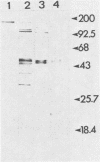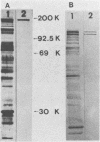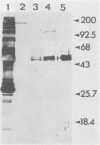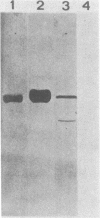Abstract
We determined the antigenic specificities of nine murine monoclonal antibodies to Giardia lamblia. Four distinct antibody reaction patterns were detected by immunofluorescence with G. lamblia trophozoites. Four monoclonal antibodies which reacted with the body but not the flagella of the whole trophozoites recognized two polypeptides of 170,000 and 155,000 molecular weights by immunoblotting. Two antibodies reacting with both the flagella and body also reacted with 170,000- and 155,000-molecular-weight antigens. An antibody specific for the G. lamblia attachment disk and two specific for flagella by immunofluorescence were found to react with 53,000- and 55,000-molecular-weight polypeptides by immunoblotting. These antigens comigrated with purified bovine brain tubulin, and their respective antibodies reacted in immunoblots with purified bovine brain tubulin. The antigens identified in this report were found to be present in Giardia cytoskeletal preparations. All antigens were pronase labile and heat stable. Four strains of G. lamblia reacted similarly in immunofluorescence assays as well as in immunoblotting assays.
Full text
PDF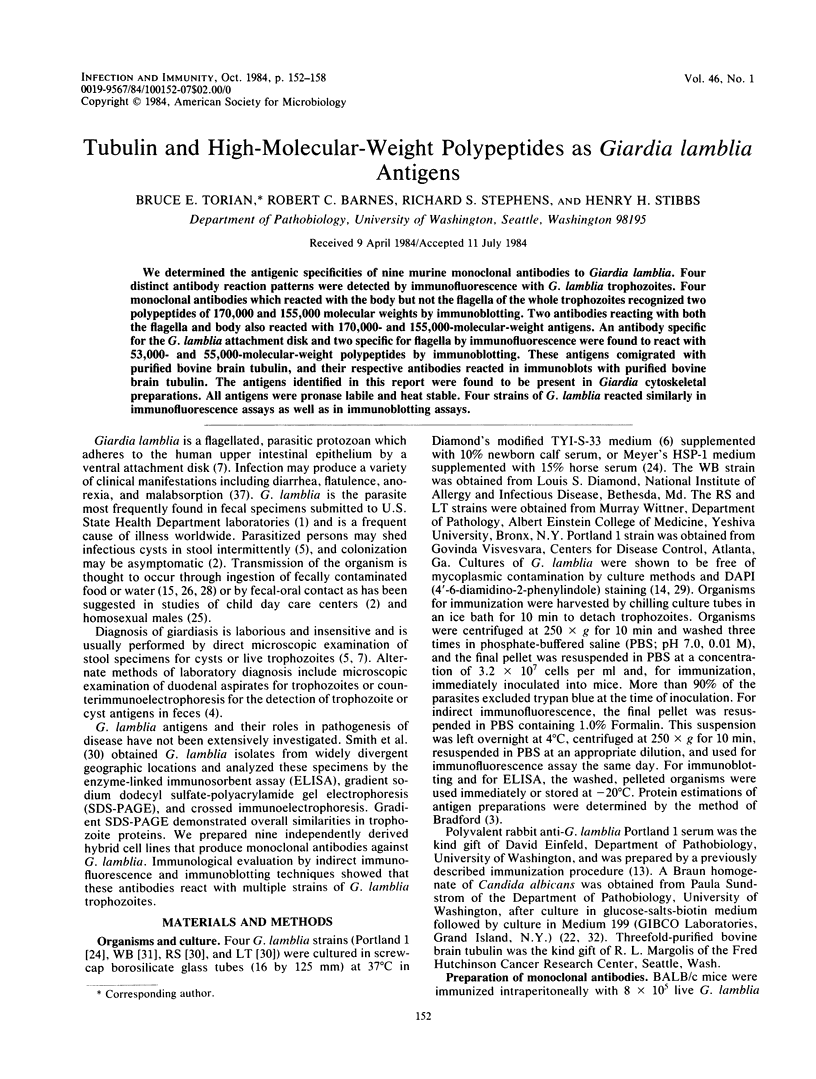
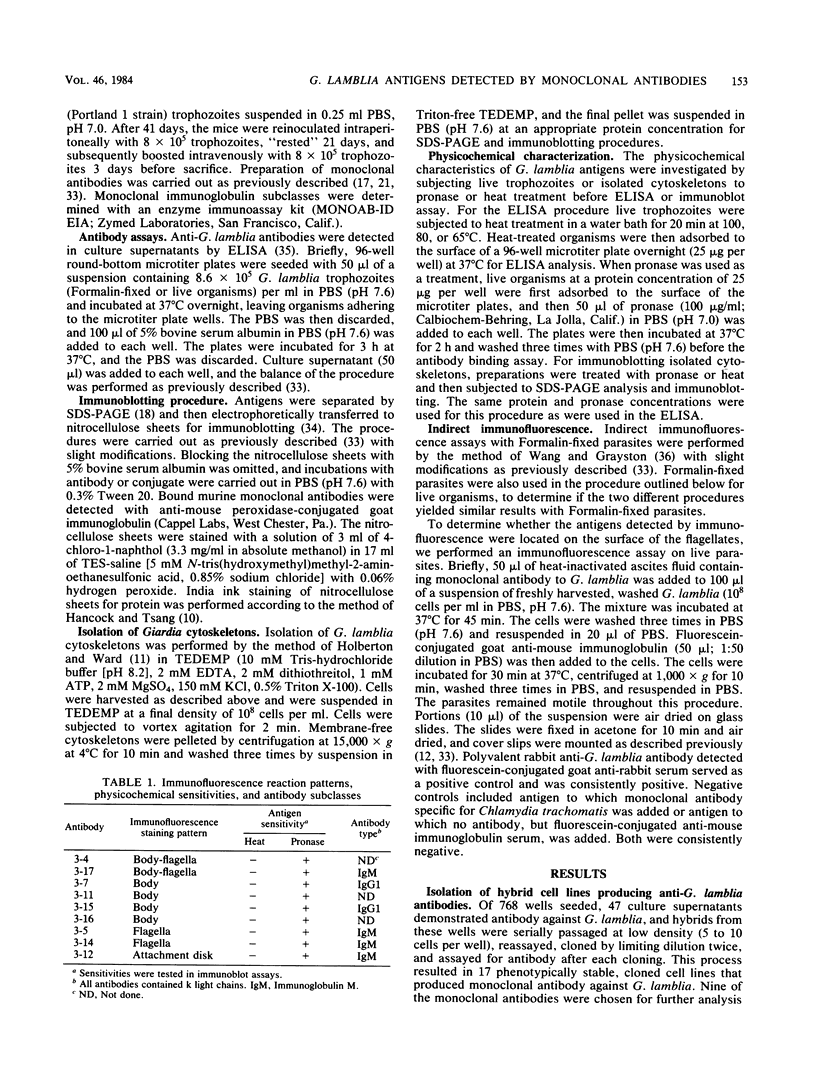
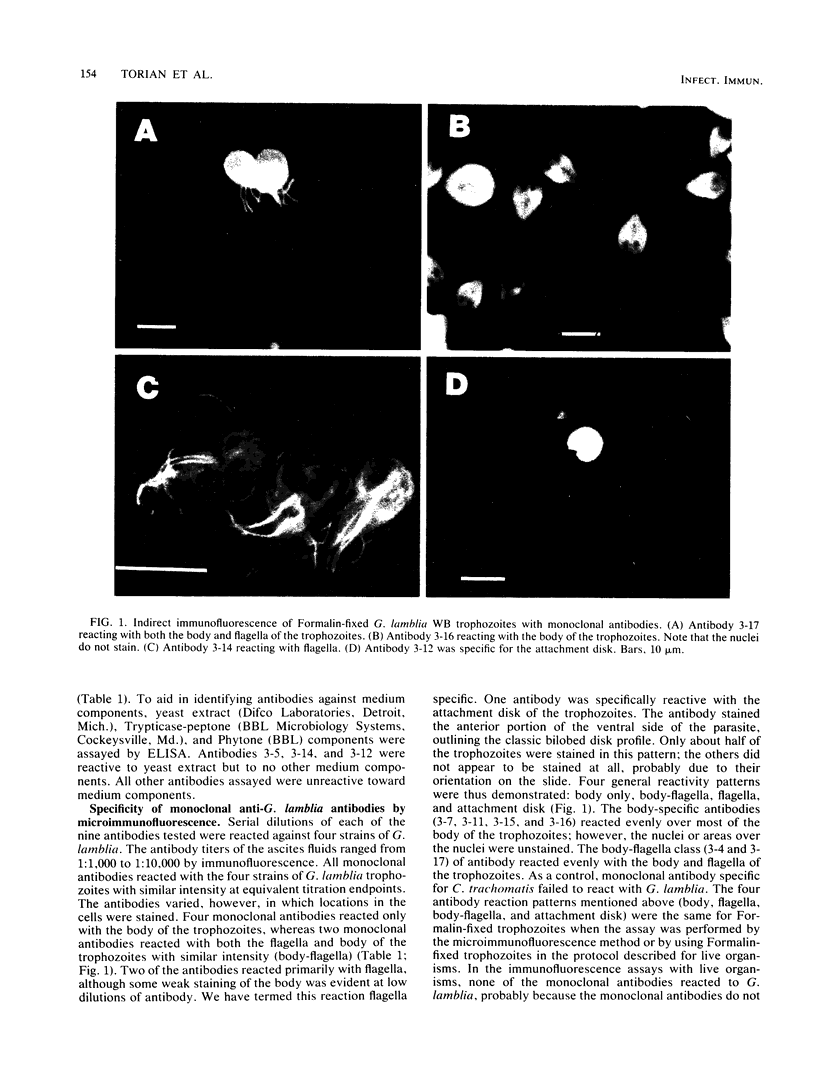
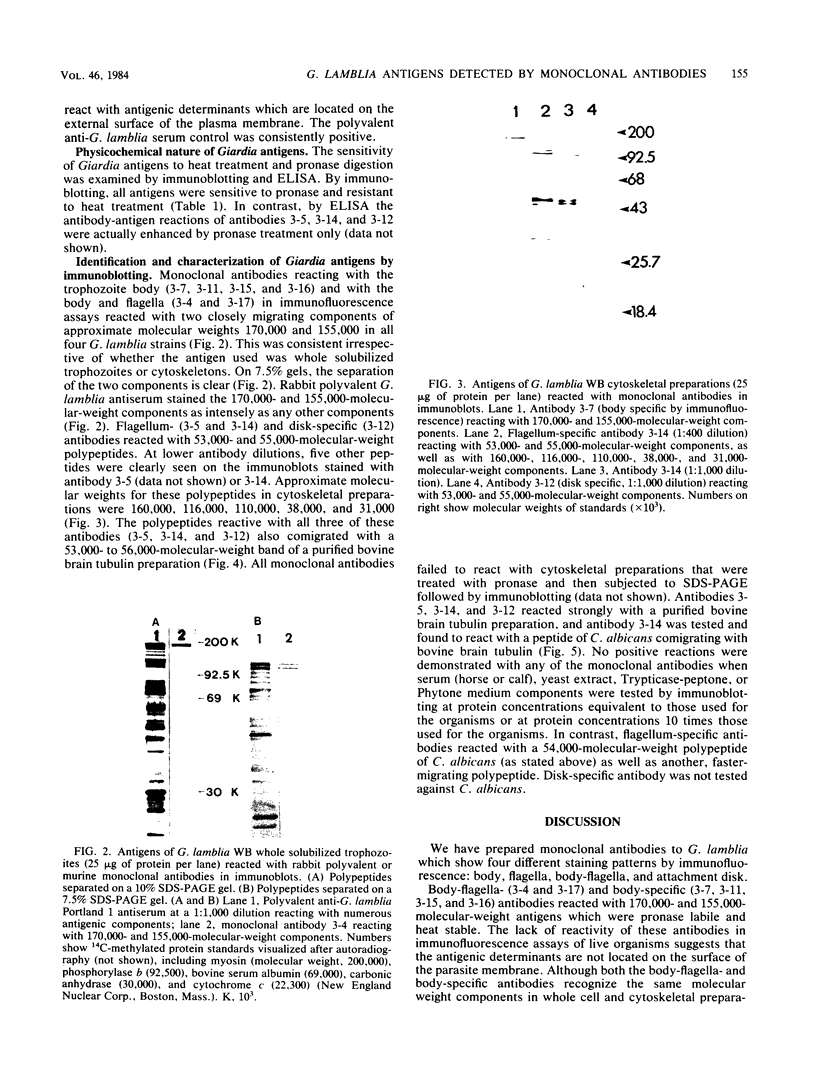
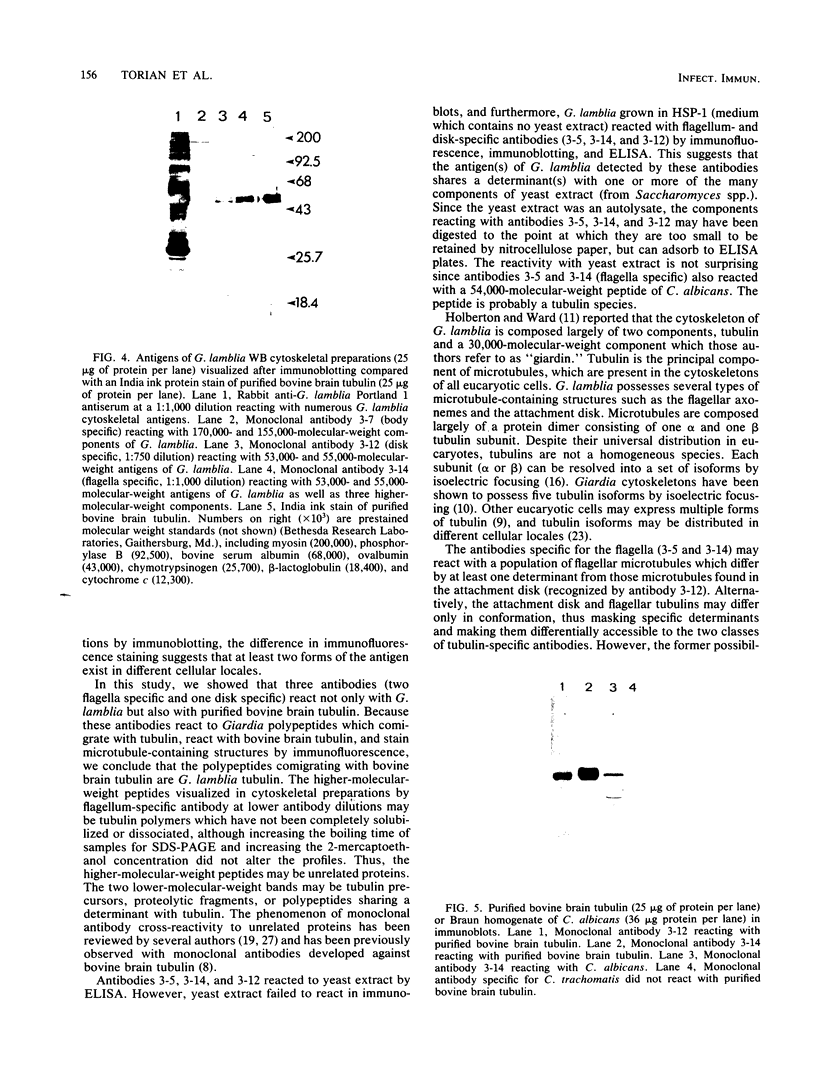
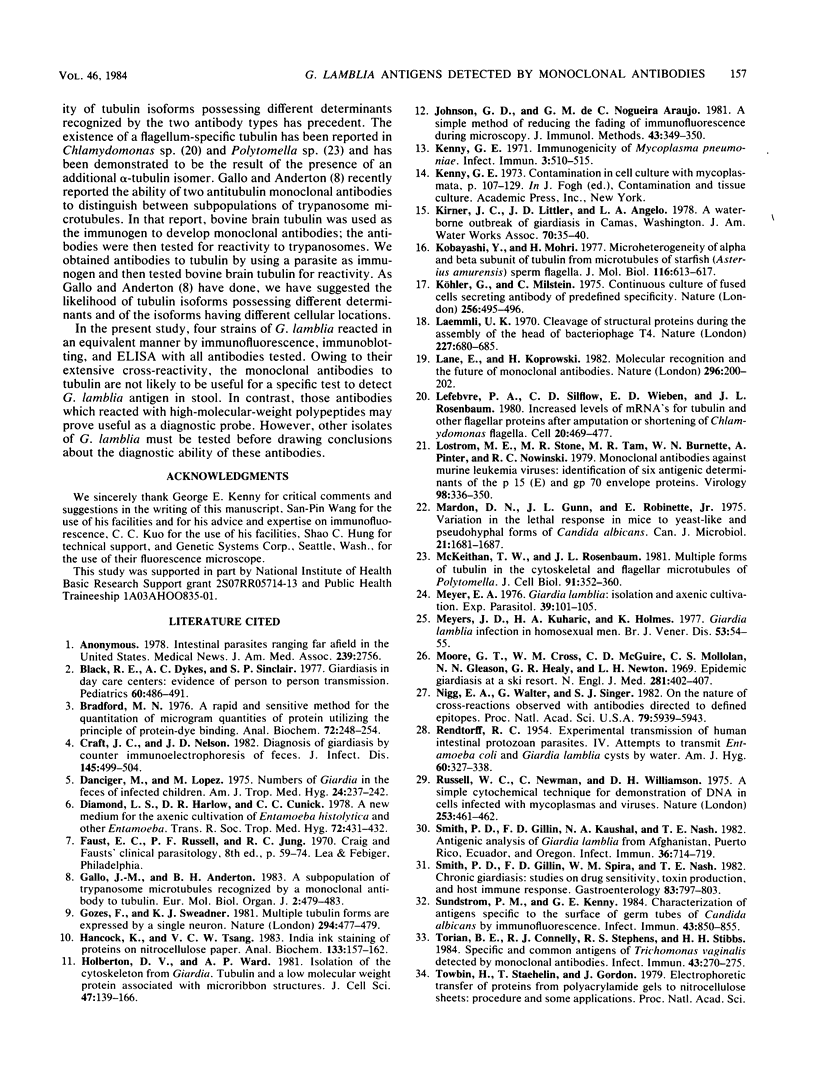
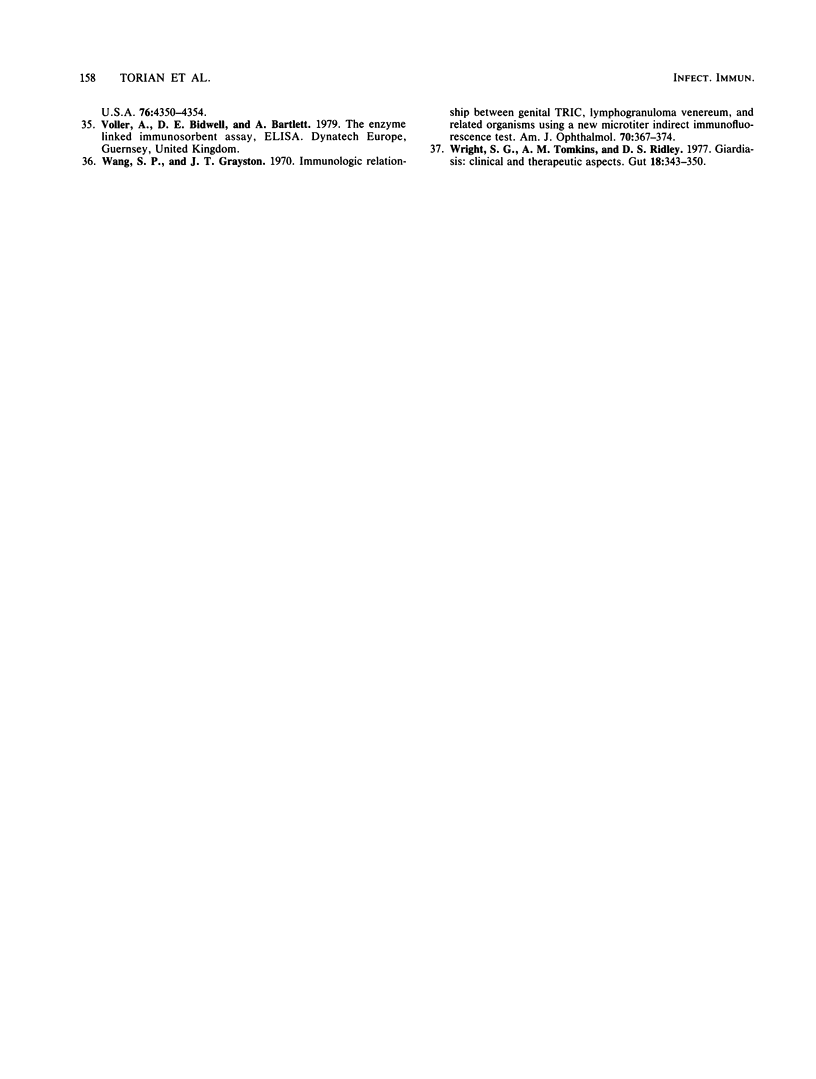
Images in this article
Selected References
These references are in PubMed. This may not be the complete list of references from this article.
- Black R. E., Dykes A. C., Sinclair S. P., Wells J. G. Giardiasis in day-care centers: evidence of person-to-person transmission. Pediatrics. 1977 Oct;60(4):486–491. [PubMed] [Google Scholar]
- Bradford M. M. A rapid and sensitive method for the quantitation of microgram quantities of protein utilizing the principle of protein-dye binding. Anal Biochem. 1976 May 7;72:248–254. doi: 10.1006/abio.1976.9999. [DOI] [PubMed] [Google Scholar]
- Craft J. C., Nelson J. D. Diagnosis of giardiasis by counterimmunoelectrophoresis of feces. J Infect Dis. 1982 Apr;145(4):499–504. doi: 10.1093/infdis/145.4.499. [DOI] [PubMed] [Google Scholar]
- Danciger M., Lopez M. Numbers of Giardia in the feces of infected children. Am J Trop Med Hyg. 1975 Mar;24(2):237–242. doi: 10.4269/ajtmh.1975.24.237. [DOI] [PubMed] [Google Scholar]
- Diamond L. S., Harlow D. R., Cunnick C. C. A new medium for the axenic cultivation of Entamoeba histolytica and other Entamoeba. Trans R Soc Trop Med Hyg. 1978;72(4):431–432. doi: 10.1016/0035-9203(78)90144-x. [DOI] [PubMed] [Google Scholar]
- Gallo J. M., Anderton B. H. A subpopulation of trypanosome microtubules recognized by a monoclonal antibody to tubulin. EMBO J. 1983;2(4):479–483. doi: 10.1002/j.1460-2075.1983.tb01450.x. [DOI] [PMC free article] [PubMed] [Google Scholar]
- Gozes I., Sweadner K. J. Multiple tubulin forms are expressed by a single neurone. Nature. 1981 Dec 3;294(5840):477–480. doi: 10.1038/294477a0. [DOI] [PubMed] [Google Scholar]
- Hancock K., Tsang V. C. India ink staining of proteins on nitrocellulose paper. Anal Biochem. 1983 Aug;133(1):157–162. doi: 10.1016/0003-2697(83)90237-3. [DOI] [PubMed] [Google Scholar]
- Holberton D. V., Ward A. P. Isolation of the cytoskeleton from Giardia. Tubulin and a low-molecular-weight protein associated with microribbon structures. J Cell Sci. 1981 Feb;47:139–166. doi: 10.1242/jcs.47.1.139. [DOI] [PubMed] [Google Scholar]
- Johnson G. D., Nogueira Araujo G. M. A simple method of reducing the fading of immunofluorescence during microscopy. J Immunol Methods. 1981;43(3):349–350. doi: 10.1016/0022-1759(81)90183-6. [DOI] [PubMed] [Google Scholar]
- Kenny G. E. Immunogenicity of Mycoplasma pneumoniae. Infect Immun. 1971 Apr;3(4):510–515. doi: 10.1128/iai.3.4.510-515.1971. [DOI] [PMC free article] [PubMed] [Google Scholar]
- Kobayashi Y., Mohri H. Microheterogeneity of alpha and beta subunit of tubulin from microtubules of starfish (Asterias amurensis) sperm flagella. J Mol Biol. 1977 Nov 5;116(3):613–617. doi: 10.1016/0022-2836(77)90089-4. [DOI] [PubMed] [Google Scholar]
- Köhler G., Milstein C. Continuous cultures of fused cells secreting antibody of predefined specificity. Nature. 1975 Aug 7;256(5517):495–497. doi: 10.1038/256495a0. [DOI] [PubMed] [Google Scholar]
- Laemmli U. K. Cleavage of structural proteins during the assembly of the head of bacteriophage T4. Nature. 1970 Aug 15;227(5259):680–685. doi: 10.1038/227680a0. [DOI] [PubMed] [Google Scholar]
- Lane D., Koprowski H. Molecular recognition and the future of monoclonal antibodies. Nature. 1982 Mar 18;296(5854):200–202. doi: 10.1038/296200a0. [DOI] [PubMed] [Google Scholar]
- Lefebvre P. A., Silflow C. D., Wieben E. D., Rosenbaum J. L. Increased levels of mRNAs for tubulin and other flagellar proteins after amputation or shortening of Chlamydomonas flagella. Cell. 1980 Jun;20(2):469–477. doi: 10.1016/0092-8674(80)90633-9. [DOI] [PubMed] [Google Scholar]
- Lostrom M. E., Stone M. R., Tam M., Burnette W. N., Pinter A., Nowinski R. C. Monoclonal antibodies against murine leukemia viruses: identification of six antigenic determinants on the p 15(E) and gp70 envelope proteins. Virology. 1979 Oct 30;98(2):336–350. doi: 10.1016/0042-6822(79)90557-9. [DOI] [PubMed] [Google Scholar]
- Mardon D. N., Gunn J. L., Robinette E., Jr Variation in the lethal response in mice to yeast-like and pseudohyphal forms of Candida albicans. Can J Microbiol. 1975 Nov;21(11):1681–1687. doi: 10.1139/m75-246. [DOI] [PubMed] [Google Scholar]
- McKeithan T. W., Rosenbaum J. L. Multiple forms of tubulin in the cytoskeletal and flagellar microtubules of Polytomella. J Cell Biol. 1981 Nov;91(2 Pt 1):352–360. doi: 10.1083/jcb.91.2.352. [DOI] [PMC free article] [PubMed] [Google Scholar]
- Meyer E. A. Giardia lamblia: isolation and axenic cultivation. Exp Parasitol. 1976 Feb;39(1):101–105. doi: 10.1016/0014-4894(76)90016-3. [DOI] [PubMed] [Google Scholar]
- Meyers J. D., Kuharic H. A., Holmes K. K. Giardia lamblia infection in homosexual men. Br J Vener Dis. 1977 Feb;53(1):54–55. doi: 10.1136/sti.53.1.54. [DOI] [PMC free article] [PubMed] [Google Scholar]
- Moore G. T., Cross W. M., McGuire D., Mollohan C. S., Gleason N. N., Healy G. R., Newton L. H. Epidemic giardiasis at a ski resort. N Engl J Med. 1969 Aug 21;281(8):402–407. doi: 10.1056/NEJM196908212810802. [DOI] [PubMed] [Google Scholar]
- Nigg E. A., Walter G., Singer S. J. On the nature of crossreactions observed with antibodies directed to defined epitopes. Proc Natl Acad Sci U S A. 1982 Oct;79(19):5939–5943. doi: 10.1073/pnas.79.19.5939. [DOI] [PMC free article] [PubMed] [Google Scholar]
- RENDTORFF R. C., HOLT C. J. The experimental transmission of human intestinal protozoan parasites. IV. Attempts to transmit Endamoeba coli and Giardia lamblia cysts by water. Am J Hyg. 1954 Nov;60(3):327–338. [PubMed] [Google Scholar]
- Russell W. C., Newman C., Williamson D. H. A simple cytochemical technique for demonstration of DNA in cells infected with mycoplasmas and viruses. Nature. 1975 Feb 6;253(5491):461–462. doi: 10.1038/253461a0. [DOI] [PubMed] [Google Scholar]
- Smith P. D., Gillin F. D., Kaushal N. A., Nash T. E. Antigenic analysis of Giardia lamblia from Afghanistan, Puerto Rico, Ecuador, and Oregon. Infect Immun. 1982 May;36(2):714–719. doi: 10.1128/iai.36.2.714-719.1982. [DOI] [PMC free article] [PubMed] [Google Scholar]
- Smith P. D., Gillin F. D., Spira W. M., Nash T. E. Chronic giardiasis: studies on drug sensitivity, toxin production, and host immune response. Gastroenterology. 1982 Oct;83(4):797–803. [PubMed] [Google Scholar]
- Sundstrom P. M., Kenny G. E. Characterization of antigens specific to the surface of germ tubes of Candida albicans by immunofluorescence. Infect Immun. 1984 Mar;43(3):850–855. doi: 10.1128/iai.43.3.850-855.1984. [DOI] [PMC free article] [PubMed] [Google Scholar]
- Torian B. E., Connelly R. J., Stephens R. S., Stibbs H. H. Specific and common antigens of Trichomonas vaginalis detected by monoclonal antibodies. Infect Immun. 1984 Jan;43(1):270–275. doi: 10.1128/iai.43.1.270-275.1984. [DOI] [PMC free article] [PubMed] [Google Scholar]
- Wang S. P., Grayston J. T. Immunologic relationship between genital TRIC, lymphogranuloma venereum, and related organisms in a new microtiter indirect immunofluorescence test. Am J Ophthalmol. 1970 Sep;70(3):367–374. doi: 10.1016/0002-9394(70)90096-6. [DOI] [PubMed] [Google Scholar]
- Wright S. G., Tomkins A. M., Ridley D. S. Giardiasis: clinical and therapeutic aspects. Gut. 1977 May;18(5):343–350. doi: 10.1136/gut.18.5.343. [DOI] [PMC free article] [PubMed] [Google Scholar]




